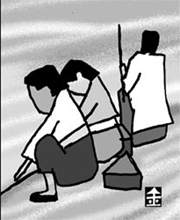Fake reality

The Meegeren case speaks powerfully about how difficult it is to determine the authenticity of a piece of art.
The more skill a forger has, the more reliant we become on scientific methods to verify authenticity. For instance, through an ultraviolet fluorescence analysis, just with the tiniest sample of pigments, the composition of the oil used to solvent and pigments can be detected. Forensic authentication also detects the oxidation level of the paper or canvas. Take, for example, the forgeries of works by Lee Jung-sup, which were confirmed by prosecutors in October of last year. They were able to determine that the forgers cut and used old material based on different degrees of oxidation.
Debate over the authenticity of one of the Park Soo-geun paintings has intensified. The authentication of that painting received a lot of attention because the piece was sold for a record-high price in a domestic art auction, 4.5 billion won ($4.8 million). There is no way critics alone can agree on the authenticity of a piece.
Use this as an opportunity to conduct a forensic authentication. A simple X-ray fluorescence can determine when the white paint on a frame was painted. If you sample a tiny bit of pigment from underneath the frame, you can also conduct ultraviolet fluorescence and infrared analysis.
I hope the unpublicized painting of Korea’s talented and much-loved painter, Park Soo-geun, will prove that his masterpiece is indeed authentic.
The writer is an editorial writer of JoongAng Ilbo.
By Cho Hyun-wook [poemlove@joongang.co.kr]










with the Korea JoongAng Daily
To write comments, please log in to one of the accounts.
Standards Board Policy (0/250자)